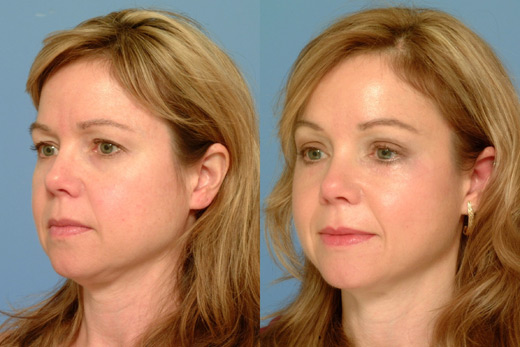

Let's have some fun today. It's been a little while since we had a little audience participation and I think it is time to change that. Sooo, it's test time again!!
Here are the rules:
1. Look at the picture and see what you think would help. (those of you who come here often will find it easy...you are educated!!).
2. The choices will be between using Botox, a Filler of some sort, laser, or a surgical procedure.

You may elect to combine the use of these tools and that is OK. I do it all the time. Today though, let's not get too complicated. In my analysis of the patient I will give you some ideas on what other things would be good for the patient. I need to feel useful in some way!!
Always remember, there is no right answer, because, in Cosmetic surgery everything is elective. You can always choose to do nothing. However, there are wrong answers. Wrong answers are when you plan to do more than the patient needs or wants. My job is to steer people away from unecessary procedures and only do what's needed or desired...today, that's your job. Good luck!!
Example #1:
Here we have a 40'ish female with no other medical problems. She complains that she looks "old" and wants a face lift or something to help her look the way she feels. Look at her closely. What do you think??
 What would you recommend:
What would you recommend:
1. Botox 2. some type of filler 3. laser 4. a surgical procedure

Example #2:
40'ish young lady who complains about the lower part of her face sagging. Her friends have told her that you have helped them and she should come talk to you about what could be done. You would recommend???
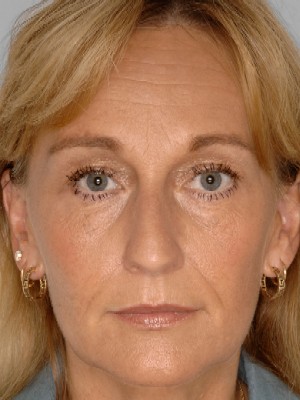 Your recommendation??
Your recommendation??
1. Botox 2. a filler of some type 3. laser 4. a surgical procedure
Example #3:
A 54 year old lady who is disgusted with her neck and just thinks she looks OLD!! She says that cost is no obstacle and wants it all fixed, or injected, or something!
[1].jpg) And the winner is....
And the winner is....
1. Botox 2. some type of filler 3. laser 4. a surgical procedure
Example #4:
28 year old female who states her boyfriend says she has "wrinkles around her mouth". She is concearned about this and wants to know what you think....
 Here she is...
Here she is...
1. Botox 2. Some type of filler 3. laser 4. surgical procedure 5. get a new boyfriend!
Example 5:
A 65 year old widow comes to you and says she has finished mourning the loss of her husband and wants to look younger so she can "get out there".
 Very nice lady....funny too....what would you recommend??
Very nice lady....funny too....what would you recommend??
1. Botox 2. some type of filler 3. laser 4. Surgical procedure 5. Birth control

Well, let's see how you did. On number one if you said Botox, that would be a great start. Most people want to start small. Botox would get rid of the lines around the eyes and in the upper face. She will eventually probably want a brow lift to eliminate the lines and the cause of them but Botox is fairly cheap and less invasive.
On number two, I would say Botox and some type of filler. This combination is great for softening wrinkles in the upper face and getting rid of nasolabial folds as this lady has. She has good facial structure and her skin is in good shape. This will make her very happy and not cost a fortune.
On number three, I would recommend a surgical procedure or two. Looking at the "hooding" over her eyes, she would benefit greatly from a brow lift. It will take years off of her appearance. She also has the "turkey gobbler" neck and jowling but her neck is not heavy. I would recommend a mini lower face and neck lift as well. She will be very happy!
On number four....get a new boyfriend of course. We see people like this sometimes and my job is to DO NOTHING. She needs to be told how beautiful she is and just how silly it would be to do anything to change that. Unfortunately, in many cases, these people will find someone to mess things up. It's sad.
Number five would need a brow lift, upper eyelids, face lift, and I would also recommend full face laser to treat the discolorations and fine lines on the rest of the face.
I hope you did well on the quiz today, and enjoyed using your own evaluation skills. If you like, let me know how you scored and if you have anything you would like addressed, send that too.
Call us at 918-786-7780 or 1-877-weight-0 to make an appointment.



 Do your lips look like you've been sucking on a sour pickle, even when you haven't?? Did you used to smoke (back when it was cool) and have the lips to prove it now??
Do your lips look like you've been sucking on a sour pickle, even when you haven't?? Did you used to smoke (back when it was cool) and have the lips to prove it now??  as in this picture. The lip is full, both upper and lower, with a nice shape and good cupids bow on the upper. Lips like these are what most women want. Others are born with thin lips that have little shape to them...
as in this picture. The lip is full, both upper and lower, with a nice shape and good cupids bow on the upper. Lips like these are what most women want. Others are born with thin lips that have little shape to them... Not that there is anything wrong with them but they do lack fullness. Obviously, this is genetics at work and there is not much that you can do about where you start.
Not that there is anything wrong with them but they do lack fullness. Obviously, this is genetics at work and there is not much that you can do about where you start.

 Here you see nasolabial folds.
Here you see nasolabial folds. Marrionette lines
Marrionette lines







 What would you recommend:
What would you recommend: Your recommendation??
Your recommendation??[1].jpg) And the winner is....
And the winner is.... Here she is...
Here she is... Very nice lady....funny too....what would you recommend??
Very nice lady....funny too....what would you recommend??

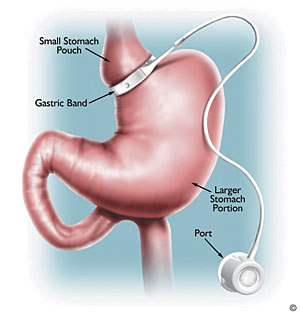 The Gastric Band on the stomach.
The Gastric Band on the stomach.



 The best way to handle them is with sclerotherapy. Now that may sound scary but really it is pretty simple. We inject the veins with a chemical that causes them to stop working. Sometimes a small clot forms in them and over time, your body resorbs the clot and vein eliminating the problem. The process is fairly easy, quick, and causes minimal pain. We have you wear a tight (compression) stocking for about two weeks after the injections and after that....nothing. You may have some areas of pigmentation in the area for a few months and this usually resolves without further treatment. Because this problem is superficial, most insurances consider this treatment Cosmetic and will not cover it under the usual policy. We charge $350 per treatment and a treatment consists of two vials of the solution we use which is the safe amount at one sitting. If more treatments are required, we usually wait about 6 weeks before re-treating. Small areas usually require only one session. Big, or multiple areas may require several sessions.
The best way to handle them is with sclerotherapy. Now that may sound scary but really it is pretty simple. We inject the veins with a chemical that causes them to stop working. Sometimes a small clot forms in them and over time, your body resorbs the clot and vein eliminating the problem. The process is fairly easy, quick, and causes minimal pain. We have you wear a tight (compression) stocking for about two weeks after the injections and after that....nothing. You may have some areas of pigmentation in the area for a few months and this usually resolves without further treatment. Because this problem is superficial, most insurances consider this treatment Cosmetic and will not cover it under the usual policy. We charge $350 per treatment and a treatment consists of two vials of the solution we use which is the safe amount at one sitting. If more treatments are required, we usually wait about 6 weeks before re-treating. Small areas usually require only one session. Big, or multiple areas may require several sessions.
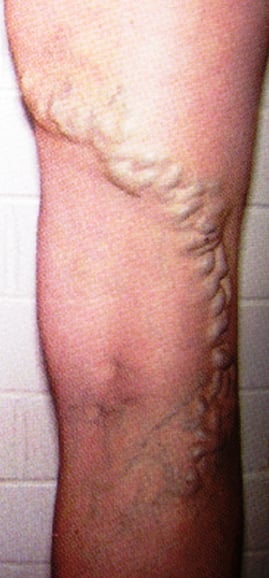 varicose veins.
varicose veins.


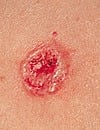 are often ulcerated with raised edges. Like a sore that never goes away. They usually only spread locally and can become quite large if left alone...
are often ulcerated with raised edges. Like a sore that never goes away. They usually only spread locally and can become quite large if left alone...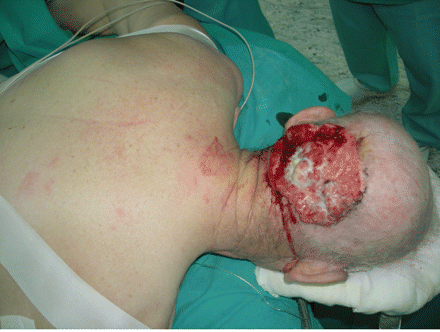 They can locally invade through bone and can require extensive surgery to remove. It is therefore wise to seek advice while these lesions are small and easily removed. We usually remove them surgically but they can also be removed by a Moh's procedure. After complete removal the tumors rarely come back unless there are multiple areas involved (multi-focal tumors). Also, the sun damage that caused the original tumor is also present on other exposed areas. Therefore, once one is removed you must be diligent to identify and remove other tumors.
They can locally invade through bone and can require extensive surgery to remove. It is therefore wise to seek advice while these lesions are small and easily removed. We usually remove them surgically but they can also be removed by a Moh's procedure. After complete removal the tumors rarely come back unless there are multiple areas involved (multi-focal tumors). Also, the sun damage that caused the original tumor is also present on other exposed areas. Therefore, once one is removed you must be diligent to identify and remove other tumors.
 This picture is pretty classic for a nodular type melanoma, irregular, varied color, and a nodule. They can, however, look like a normal mole. Any pigmented lesion on the skin should be watched for change or increase in size. Treating melanoma early is critical to survival and recovery. Early treatment means less chance of spread to other places.
This picture is pretty classic for a nodular type melanoma, irregular, varied color, and a nodule. They can, however, look like a normal mole. Any pigmented lesion on the skin should be watched for change or increase in size. Treating melanoma early is critical to survival and recovery. Early treatment means less chance of spread to other places.




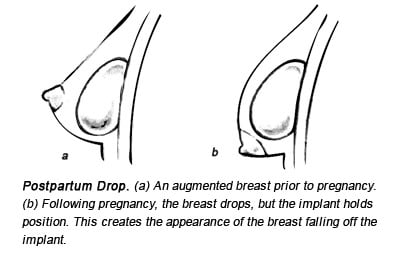

 This picture demonstrates stretch marks and a lower abdominal scar in the mid line from a c. section or hysterectomy...definitely from pregnancy. Liposuction alone will not correct this problem, only a tummy tuck will do. You can also see the fatty tissue in the "love handle" area creating the dreaded muffin top in pants. This can be corrected by liposuction.
This picture demonstrates stretch marks and a lower abdominal scar in the mid line from a c. section or hysterectomy...definitely from pregnancy. Liposuction alone will not correct this problem, only a tummy tuck will do. You can also see the fatty tissue in the "love handle" area creating the dreaded muffin top in pants. This can be corrected by liposuction.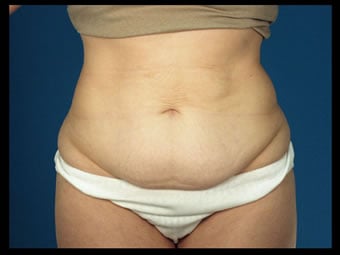 In this photo you see the lower abdominal apron that can form with weight gain and loss along with pregnancy. No matter how much you exercise, it is darn near impossible to get rid of this. Both of these pictures also show the "pooching" of the lower abdomen as the connective tissue stretches with pregnancy.
In this photo you see the lower abdominal apron that can form with weight gain and loss along with pregnancy. No matter how much you exercise, it is darn near impossible to get rid of this. Both of these pictures also show the "pooching" of the lower abdomen as the connective tissue stretches with pregnancy. An Men....just when you thought it was safe....it can happen to us too ya know. With large weight gains and losses they can develope. Some supplements can also cause the problem. And men have a tendency to form love handles as a matter of genetics.
An Men....just when you thought it was safe....it can happen to us too ya know. With large weight gains and losses they can develope. Some supplements can also cause the problem. And men have a tendency to form love handles as a matter of genetics.


 Do you ever feel like this? What is a brow lift and when do I need one? How do you know if it's the eyelid or the brow? This week I hope to give you the information you need if you have these questions, or know someone who does.
Do you ever feel like this? What is a brow lift and when do I need one? How do you know if it's the eyelid or the brow? This week I hope to give you the information you need if you have these questions, or know someone who does.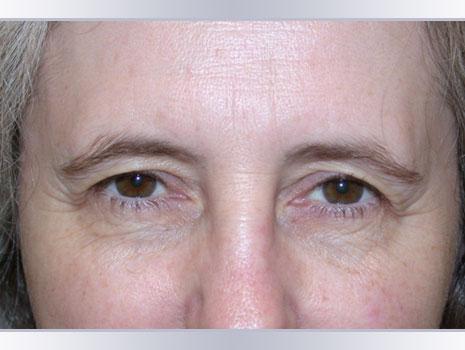 If you look closely at this picture, what do you see? First, it looks like her lids are drooping. On closer inspection, the problem is a little more subtle. If you look at the brow position, it is very low. There is a hood over the outside of the eyelid and out over the outside of the eye. This is a tell-tale sign....lateral hooding. The second thing you notice is how low the eyebrow is in relation to the eye. In females, the normal position should be above the boney rim of the upper eye and should have an arch to it that is highest at about the outer iris (colored part of the eye). Her brow is far from being in the proper position...it is very low. She may come asking to have her eyelids fixed, and without further examination, she may be right, but the primary problem is her brow.
If you look closely at this picture, what do you see? First, it looks like her lids are drooping. On closer inspection, the problem is a little more subtle. If you look at the brow position, it is very low. There is a hood over the outside of the eyelid and out over the outside of the eye. This is a tell-tale sign....lateral hooding. The second thing you notice is how low the eyebrow is in relation to the eye. In females, the normal position should be above the boney rim of the upper eye and should have an arch to it that is highest at about the outer iris (colored part of the eye). Her brow is far from being in the proper position...it is very low. She may come asking to have her eyelids fixed, and without further examination, she may be right, but the primary problem is her brow.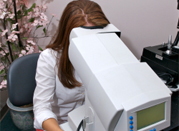 (Visual field testing.)
(Visual field testing.)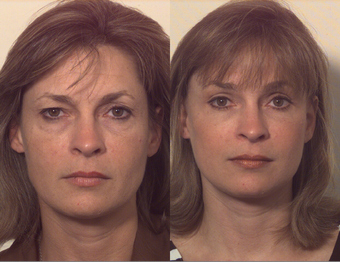 This is a great example of an eyelid problem only. If you look closely you see that the brow position is exactly as we discussed. The brow is in a good position as far as it relates to the boney part of the eye socket, and it is arched nicely. Also note that there is no lateral hooding present as we saw in the previous picture. It is the eyelids that are the problem and a simple blepharoplasty is sufficient to fix this. This is a great result by the way, off of google images.
This is a great example of an eyelid problem only. If you look closely you see that the brow position is exactly as we discussed. The brow is in a good position as far as it relates to the boney part of the eye socket, and it is arched nicely. Also note that there is no lateral hooding present as we saw in the previous picture. It is the eyelids that are the problem and a simple blepharoplasty is sufficient to fix this. This is a great result by the way, off of google images. This picture depicts where the small incisions are placed for a brow lift. We shave no hair, the hair line stays the same, and the results are just as good as the old big incision.
This picture depicts where the small incisions are placed for a brow lift. We shave no hair, the hair line stays the same, and the results are just as good as the old big incision.